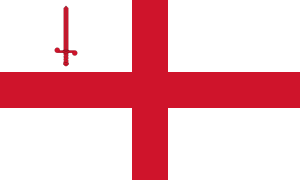Flag of England facts for kids
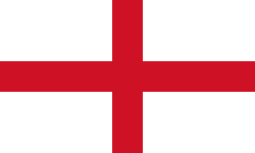 |
|
| Use | Civil and state flag |
|---|---|
| Proportion | 3:5 |
| Design | A white field with centred red cross (Argent, a cross gules) |
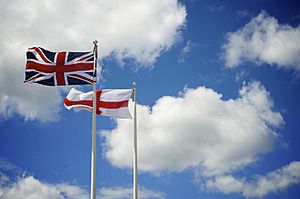
The flag of England shows a red cross on a white background. This design comes from Saint George's Cross. People started using the red cross as a symbol for England a long time ago, in the Late Middle Ages. It became more popular after the English Reformation. It was especially used as a flag for ships, known as a white ensign.
In 1606, the English flag was combined with the Scottish flag to create the Union Jack. Since the 1990s, the flag of England has been widely used. You often see it at national sports events, especially when England's national football team plays.
Contents
History of the English Flag


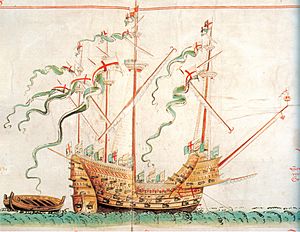
The story of the English flag goes back to 1188. At that time, Henry II of England and Philip II of France agreed to go on a crusade (a religious war). Henry was to use a white cross, and Philip a red cross. Later, the English switched to using the red cross on a white background.
Some people believed that Richard the Lionheart brought the flag and its patron saint from Genoa during his crusade. However, historians today say there is no real proof for this idea.
Red crosses were used by English soldiers to tell them apart from others. This started around the 1270s, during the time of King Edward I. For example, in the Battle of Evesham in 1265, English soldiers wore red crosses. This helped them stand out from the rebel barons who wore white crosses.
Records from 1277 show that cloth was bought to make many small flags and armbands. These items had the "arms of Saint George" for the king's foot soldiers. This suggests that King Edward I helped make the Cross of St George a "national emblem." By 1300, a larger "banner of St George" also existed.
Saint George became popular as a "warrior saint" during the crusades. But for a long time, Edward the Confessor was more closely linked to England. This changed when King Edward III gave Saint George a special role in 1348. This was after Edward III believed Saint George helped him win the Battle of Crécy. From then on, Saint George's banner was used more and more alongside the royal banner.
In 1497, John Cabot sailed to Newfoundland for King Henry VII. He reportedly took St. George's banner with him.
Saint George's Day became an important holiday from 1415. However, Saint George only became the main patron saint of England during the English Reformation. This happened around 1552, when most other religious flags were removed, except for his. The St. George's Cross was first used as a flag for ships in 1545. In 1606, it was combined with Scotland's flag to create the Union Jack.
The idea of a national flag for a country, separate from royal or military flags, became popular in the late 1700s. In the 1800s, many European nations wanted their own national flags. At that time, "Britain" and "England" were often used to mean the same thing. So, the Union Flag was often used as England's national flag, even though it was never officially declared as such.
Flags Based on the English Flag
The Union Flag
The flag of England is a key part of the Union Flag. The Union Flag has been used in different ways since 1606. This was when the flags of Scotland and England were first joined. This showed the Union of the Crowns, which happened in 1603.
In 1707, the Acts of Union joined the Kingdom of Scotland and the Kingdom of England. They became the Kingdom of Great Britain. It was decided that the crosses of St. George and St. Andrew would be joined together. This new flag would be used for all flags, banners, and ensigns, both on land and at sea.
In 1801, the St Patrick's Cross was added to the flag. This was to show the union of Great Britain with the Kingdom of Ireland. This new design became the flag of the United Kingdom of Great Britain and Ireland. The Flag of the United Kingdom is still the same today. It is the flag of the United Kingdom of Great Britain and Northern Ireland.
-
The Saint George's Cross. In the Union Flag this represents the whole Kingdom of England, including Wales.
-
The English version of the First Union Flag, from 1606. It was mostly used in England. From 1707, it became the flag of the Kingdom of Great Britain.
-
The Scottish version of the First Union Flag. It was used a little in Scotland from 1606 to 1707.
-
The Second Union Flag, from 1801. It includes the Cross of Saint Patrick. This happened after the Union of Great Britain and Kingdom of Ireland.
City of London Flag
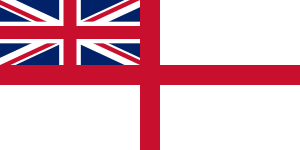
The Flag of the City of London is based on the English flag. It has a red St George's Cross on a white background. In the top left corner, there is a red sword. Many believe this sword stands for the sword that beheaded Saint Paul. He is the patron saint of the city.
The flag used by the British Royal Navy is called the White Ensign. It also uses the flag of England. It has the St George's Cross and a Union Flag in the top left corner. Other countries in the Commonwealth of Nations also use similar White Ensigns. They often have their own national flags in the corner.
How the English Flag is Used Today

Church of England
Churches that belong to the Church of England can fly the St George's Cross. Since 1938, the correct way is for the church to fly the St George's Cross. It should also have the symbol of its local church area (diocese) in the top left corner.
At Sporting Events
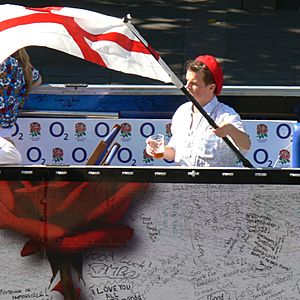
You often see the flag during sports events where England competes. This includes England Cricket matches, Rugby Union matches, and football games. It is also used online and on TV to show teams and players from England.
Before 1996, most fans waved Union Flags. Now, most fans wave the England flag. Sometimes, people add the word 'England' across the middle red bar of the flag.
Queen's 90th Birthday
In May 2016, the St George's Cross was flown from horseback during The Queen's 90th birthday celebration. This happened at Windsor. It was flown alongside the flags of Northern Ireland, Scotland, and Wales.
Showing English Identity
The St George's Cross is the national flag of England. It is used by people who want to show their English identity. This is sometimes done to show that England is different from the whole United Kingdom. This is similar to how the flag of Scotland is used to show Scottish identity.
Since the mid-1990s, the flag has been widely used at sporting events. Because of this, it is now often flown by people and local governments across the country.
English Flag in Other Places
Because of the British Empire, the flag of England has been used on flags and coats of arms in many countries, states, and provinces. The St. George's Cross is also used as the city flag for some cities in Northern Italy, like Milan and Bologna.
Canada
-
Flag of Canada
(1868–1921)
Channel Islands
Other Places Around the World
-
Naval Ensign of Barbados
-
Flag of the East India Company (1600–1707)
-
Colonial Flag of Jamaica
-
Flag of New South Wales, Australia
-
Flag of the Governor of New South Wales, Australia
-
Flag of Prince George's County, Maryland, United States
-
Former flag of the Governor of Northern Ireland
-
Flag of the Governor of Saint Helena
Images for kids
-
Angels wearing King Richard II's badge. They hold the flag of Saint George with a globe showing a tiny map of England. From the Wilton Diptych (around 1395–1399).
See also
 In Spanish: Bandera de Inglaterra para niños
In Spanish: Bandera de Inglaterra para niños






